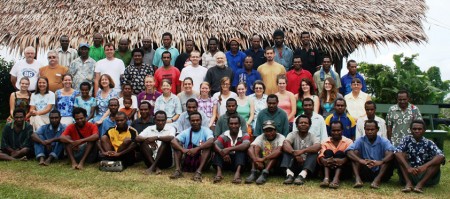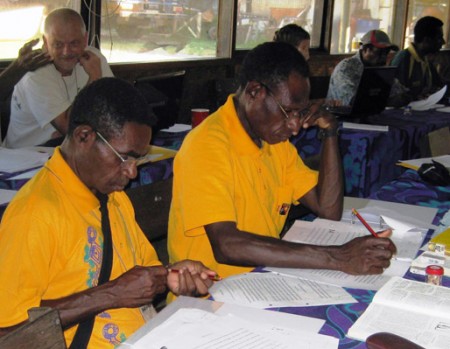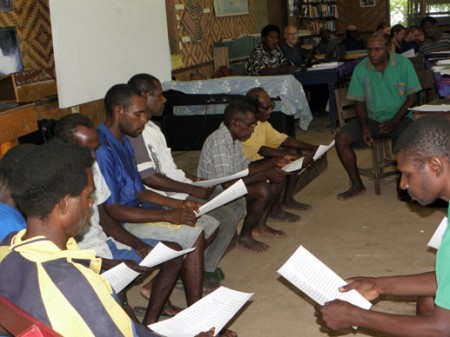by Diane Miller
 Why were forty-one Papua New Guinean men and women from nine different language groups gathered with assorted “whiteskins” on a beautiful hillside location not far from Madang? These people attended and staffed a village checking and back translation course for national Bible translators which PBT offered this summer. Eleven young mission interns from the U.S. used the Melanesian Pidgin (one of two trade languages in Papua New Guinea with which people from over 800 language groups can communicate with each other) they had learned in village experiences previous to the course to communicate with the nationals. They presented devotionals in Pidgin, entered various data into computers and made other valuable contributions.
Why were forty-one Papua New Guinean men and women from nine different language groups gathered with assorted “whiteskins” on a beautiful hillside location not far from Madang? These people attended and staffed a village checking and back translation course for national Bible translators which PBT offered this summer. Eleven young mission interns from the U.S. used the Melanesian Pidgin (one of two trade languages in Papua New Guinea with which people from over 800 language groups can communicate with each other) they had learned in village experiences previous to the course to communicate with the nationals. They presented devotionals in Pidgin, entered various data into computers and made other valuable contributions.

My job was to mentor two Bible translators from one of the nine language groups in the village checking class. After instruction from Martha Wade on how to check vernacular translation drafts with the Pidgin Bible for improper translation, and missing or added information, they perused copies of Bible passages they had translated and made necessary revisions. Next we considered some questions that an adviser who formerly worked with these translators, had sent after he reviewed their translation drafts. Further revisions were then made. Their corrected drafts were carried to their co-workers in the Back translation class who translated the vernacular back into Melanesian Pidgin. If this back translation did not match what the two translators had tried to express in their heart language, then additional revisions were made to clarify the meaning. After that the men in the village checking portion of the class wrote Who? What? When? Where? and How? questions about the passages they had translated, which can be used to test whether villagers can really understand their translation, or whether yet more revisions will be necessary. Each group had opportunity to experiment with their peers in asking these questions and, near the end of the course, one group even brought people from their language group, who were staying nearby, to conduct a simulated village checking session.

There were many positive evaluative comments at the end of the course. The students appreciated the help in making their translations both accurate and natural. Some mentioned that they enjoyed making new friends and seeing how Papua New Guineans from different language groups and the foreign missionaries could work together to strengthen God’s work and keep Bible translation moving forward. Please pray for these national translators as they seek to apply what they learned in this course.
Diane is currently helping to edit the Melanesian Pidgin Elementary One (First Grade) Curriculum that will be adapted into first grade school curriculum for many language groups.